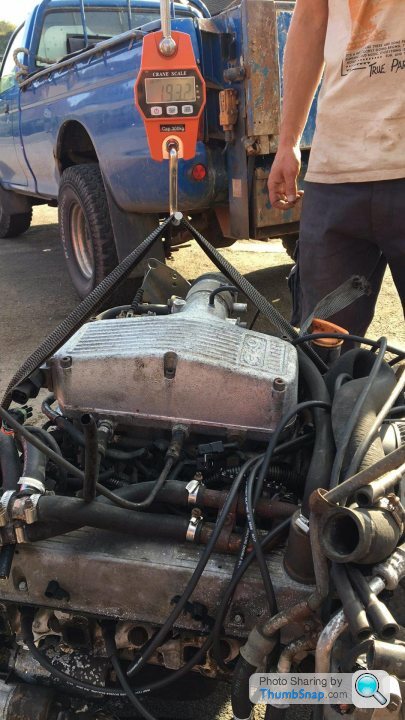weight of Rover V8
Discussion
I controlled weights when I swapped to the LS2. Old 500 complete with alternator, plenum, AC compressor, headers without cats, flywheel/clutch and T-5 gearbox was 258kg. Subtract 34 kg for the T-5 and you have 224kg. The similar complete LS2 with TKO600 but without AC-compressor weighted in at 265kg. Subtract 48kg for the TKO and you have 217kg. I used digital weight equipment, so these figures should be pretty accurate. per
Edited by Pete500 on Sunday 11th January 18:00
This has come up several times before.
The Rover V8 is not light weight, it tips the scales at circa 440lbs.
It's only light compared to the massive iron blocked stuff that was around when it was first designed, which is probably how the myth started. By todays standards it's down on power and overweight for its capacity.
Marquis Rex actually worked at BL on this engine. This is his response to this issue:
The Rover V8 is not light weight, it tips the scales at circa 440lbs.
It's only light compared to the massive iron blocked stuff that was around when it was first designed, which is probably how the myth started. By todays standards it's down on power and overweight for its capacity.
Marquis Rex actually worked at BL on this engine. This is his response to this issue:
Marquis_Rex said:
I'm tired of the hype surrounding the RV8 engine. Man, I've heard figures as low as 130 Kgs being banded about for its weight. It's a widely used readily available engine- and there's a lot of tuning knowledge out there for it (some of the tuning is questionable).
But lets put things into perspective here:
These are the true weights of a late Disco 4 litre engine, compliant with all the modern emissions and refinement criteria.
Accessory Drive Belt - (1) 0.341kg
Air Cleaner Body 0.977kg
Air Cleaner Element 0.299kg
Air Cleaner Top 0.467kg
Air Flow Meter 0.226kg
Air Hose/Duct - (1) 0.325kg
Alternator 7.196kg
Engine Complete 177.000kg
Engine Management - E.C.U. 0.390kg
Starter Motor 4.060kg
Viscous Coupling 2.942kg
Engine Oil 5.676kg
The above comes to 200 kgs. Now an earlier vehicle will probably NOT have the reduction gear starter motor fitted and so you can expect that to weigh about 8 kgs, the accessory drive won't be poly belt driven but individually driven So that will weigh quite a bit more. The above also does NOT include the flywheel, which on the Rover is very very heavy compared to it's contemporaries. So we're already looking at way over 220 Kgs.
The extra capacity over the 3.5 litre will lose some in the crank area, but because the RV8 doesn't have a fully counterweighted crankshaft- not as much as you might imagine. The block has been reinforced since the early days, but I can't see that adding much more then about 5-6 kgs. So these silly figures of around 140Kgs are Science Fiction.
When folk start to pitch this motor, on function, against the Chevy C5 motor or a twin cam Jag, BMW, or Porsche V8s spending thousands upon thousands and seriously believing all the hype, they're on shaky ground.
But lets put things into perspective here:
These are the true weights of a late Disco 4 litre engine, compliant with all the modern emissions and refinement criteria.
Accessory Drive Belt - (1) 0.341kg
Air Cleaner Body 0.977kg
Air Cleaner Element 0.299kg
Air Cleaner Top 0.467kg
Air Flow Meter 0.226kg
Air Hose/Duct - (1) 0.325kg
Alternator 7.196kg
Engine Complete 177.000kg
Engine Management - E.C.U. 0.390kg
Starter Motor 4.060kg
Viscous Coupling 2.942kg
Engine Oil 5.676kg
The above comes to 200 kgs. Now an earlier vehicle will probably NOT have the reduction gear starter motor fitted and so you can expect that to weigh about 8 kgs, the accessory drive won't be poly belt driven but individually driven So that will weigh quite a bit more. The above also does NOT include the flywheel, which on the Rover is very very heavy compared to it's contemporaries. So we're already looking at way over 220 Kgs.
The extra capacity over the 3.5 litre will lose some in the crank area, but because the RV8 doesn't have a fully counterweighted crankshaft- not as much as you might imagine. The block has been reinforced since the early days, but I can't see that adding much more then about 5-6 kgs. So these silly figures of around 140Kgs are Science Fiction.
When folk start to pitch this motor, on function, against the Chevy C5 motor or a twin cam Jag, BMW, or Porsche V8s spending thousands upon thousands and seriously believing all the hype, they're on shaky ground.
It is actually surprising where the weight is TBH. I can easily manage a block, but a box of the main caps seems unduly heavy, maybe we should actually start weighing bits and compile our own reference. I'm guessing bathroom scales will be accurate enough for the components? Or is that a bit too nerdy?
Gassing Station | Engines & Drivetrain | Top of Page | What's New | My Stuff







